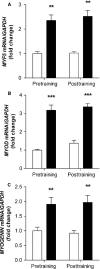Early myogenic responses to acute exercise before and after resistance training in young men
- PMID: 26359239
- PMCID: PMC4600377
- DOI: 10.14814/phy2.12511
Early myogenic responses to acute exercise before and after resistance training in young men
Abstract
To enable dynamic regulation of muscle mass and myofiber repair following injury, a satellite cell precursor population exists to supply additional nuclei. Activated satellite cells express many genes and associated proteins necessary for maturation and incorporation into the damaged fiber. There is little knowledge about the response of these markers following whole-body resistance exercise training. We investigated the impact of 12 weeks of progressive whole-body resistance training on the expression of MRFs, PAX7, NCAM, and FA1, incorporating both acute and chronic resistance exercise components. Ten young recreationally active males (21.2 ± 3.5 years) performed 12 weeks of whole-body resistance training at 70-85% of their predetermined one-repetition maximum (1RM). At the initiation and completion of the training period, muscular strength was assessed by RM and dynamometer testing, and vastus lateralis samples were obtained prior to and 3 h following an acute resistance exercise test (both whole-body and isometric exercises). Increased mRNA expression of PAX7 (threefold), NCAM (threefold), MYF5 (threefold), MYOD (threefold) and MYOGENIN (twofold) was observed 3 h after the acute resistance exercise test, both pre and posttraining. Similarly, PAX7 (11-fold) and FA1 (twofold) protein abundance increased after acute exercise, while resting NCAM (eightfold) and FA1 (threefold) protein abundance increased following 12 weeks of resistance training. It is possible that these molecular changes are primarily due to the preceding exercise bout, and are not modified by long-term or whole-body exercise training.
Keywords: Acute exercise; myogenic regulatory factors; resistance exercise training.
© 2015 The Authors. Physiological Reports published by Wiley Periodicals, Inc. on behalf of the American Physiological Society and The Physiological Society.
Figures



Similar articles
-
Consistent expression pattern of myogenic regulatory factors in whole muscle and isolated human muscle satellite cells after eccentric contractions in humans.J Appl Physiol (1985). 2019 Nov 1;127(5):1419-1426. doi: 10.1152/japplphysiol.01123.2018. Epub 2019 Sep 12. J Appl Physiol (1985). 2019. PMID: 31513447 Free PMC article.
-
Altered muscle satellite cell activation following 16 wk of resistance training in young men.Am J Physiol Regul Integr Comp Physiol. 2017 Jan 1;312(1):R85-R92. doi: 10.1152/ajpregu.00221.2016. Epub 2016 Nov 9. Am J Physiol Regul Integr Comp Physiol. 2017. PMID: 27834290 Free PMC article.
-
Satellite cell response to concurrent resistance exercise and high-intensity interval training in sedentary, overweight/obese, middle-aged individuals.Eur J Appl Physiol. 2018 Feb;118(2):225-238. doi: 10.1007/s00421-017-3721-y. Epub 2017 Oct 25. Eur J Appl Physiol. 2018. PMID: 29071380 Free PMC article.
-
The molecular regulation of muscle stem cell function.Cold Spring Harb Symp Quant Biol. 2008;73:323-31. doi: 10.1101/sqb.2008.73.064. Epub 2009 Mar 27. Cold Spring Harb Symp Quant Biol. 2008. PMID: 19329572 Review.
-
The Effects of Dietary Protein Supplementation on Acute Changes in Muscle Protein Synthesis and Longer-Term Changes in Muscle Mass, Strength, and Aerobic Capacity in Response to Concurrent Resistance and Endurance Exercise in Healthy Adults: A Systematic Review.Sports Med. 2022 Jun;52(6):1295-1328. doi: 10.1007/s40279-021-01620-9. Epub 2022 Feb 3. Sports Med. 2022. PMID: 35113389
Cited by
-
No dynamic changes in the expression of genes related to the epigenetic mechanism during acute exercise.J Appl Genet. 2023 Feb;64(1):81-87. doi: 10.1007/s13353-022-00736-6. Epub 2022 Nov 10. J Appl Genet. 2023. PMID: 36352208 Free PMC article.
-
Skeletal muscle atrophy, regeneration, and dysfunction in heart failure: Impact of exercise training.J Sport Health Sci. 2023 Sep;12(5):557-567. doi: 10.1016/j.jshs.2023.04.001. Epub 2023 Apr 9. J Sport Health Sci. 2023. PMID: 37040849 Free PMC article. Review.
-
Ficus lindsayana Leaf Extract Protects C2C12 Mouse Myoblasts Against the Suppressive Effects of Bisphenol-A on Myogenic Differentiation.Int J Mol Sci. 2025 Jan 8;26(2):476. doi: 10.3390/ijms26020476. Int J Mol Sci. 2025. PMID: 39859191 Free PMC article.
-
The Role of Forced and Voluntary Training on Accumulation of Neural Cell Adhesion Molecule and Polysialic Acid in Muscle of Mice with Experimental Autoimmune Encephalomyelitis.Evid Based Complement Alternat Med. 2020 Apr 8;2020:5160958. doi: 10.1155/2020/5160958. eCollection 2020. Evid Based Complement Alternat Med. 2020. PMID: 32328133 Free PMC article.
-
Fundamental Body Composition Principles Provide Context for Fat-Free and Skeletal Muscle Loss With GLP-1 RA Treatments.J Endocr Soc. 2024 Sep 25;8(11):bvae164. doi: 10.1210/jendso/bvae164. eCollection 2024 Sep 26. J Endocr Soc. 2024. PMID: 39372917 Free PMC article. Review.
References
-
- Whaley MH, Brubaker PH, Otto RM. Armstrong LE. American College of Sports Medicine. ACSM's guidelines for exercise testing and prescription. Baltimore, MD: Lippincott Williams & Wilkins; 2006. pp. 81–82. , and.
-
- Andersen DC, Petersson SJ, Jorgensen LH, Bollen P, Jensen PB, Teisner B, et al. Characterization of DLK1 + cells emerging during skeletal muscle remodeling in response to myositis, myopathies, and acute injury. Stem Cells. 2009;27:898–908. - PubMed
-
- Bergstrom J. Percutaneous needle biopsy of skeletal muscle in physiological and clinical research. Scand. J. Clin. Lab. Invest. 1975;35:609–616. - PubMed
-
- Bickel CS, Slade J, Mahoney E, Haddad F, Dudley GA. Adams GR. Time course of molecular responses of human skeletal muscle to acute bouts of resistance exercise. J. Appl. Physiol. 2005;98:482–488. , and. - PubMed
LinkOut - more resources
Full Text Sources
Other Literature Sources
Research Materials
Miscellaneous

